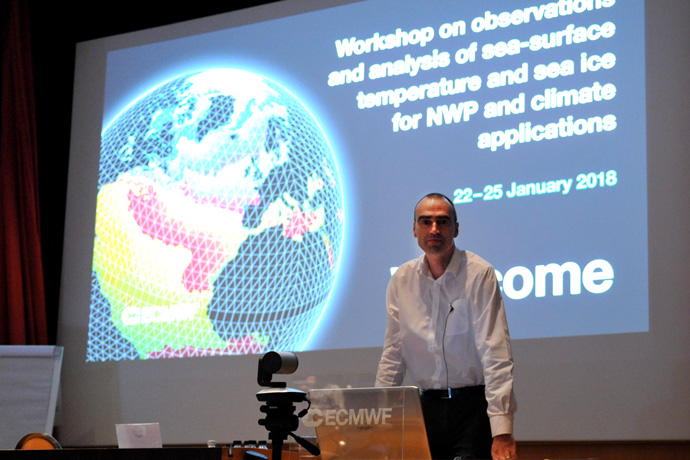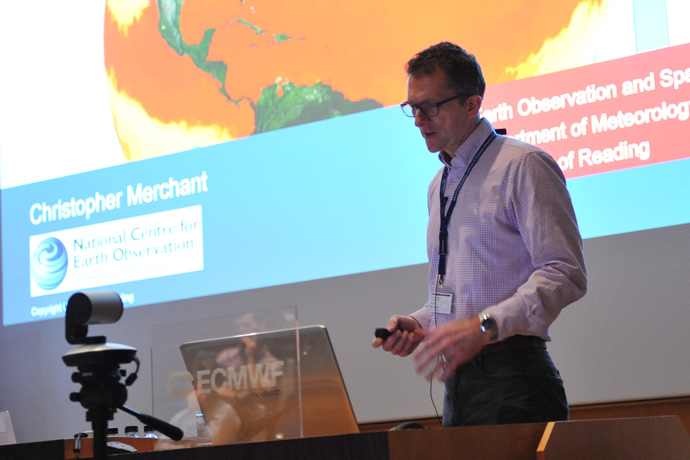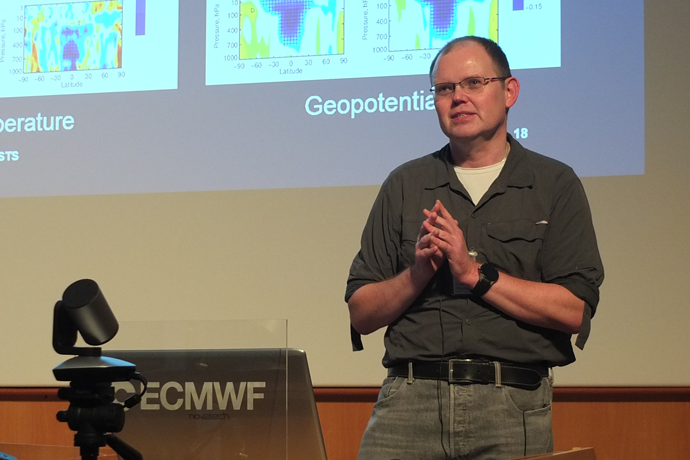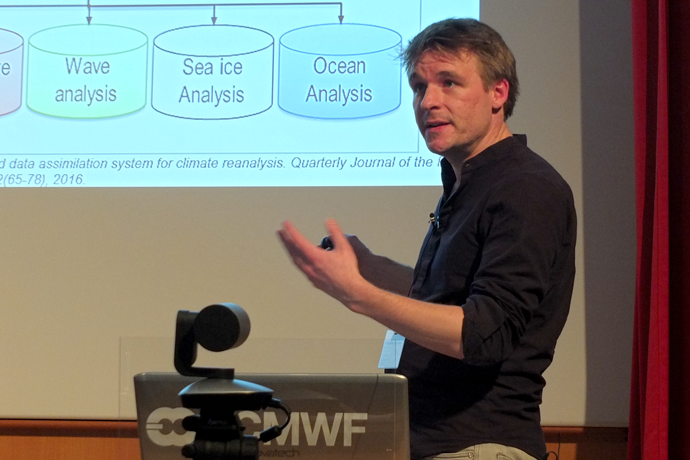

ECMWF Director of Research Andy Brown opened the workshop.
More than 50 ocean and data assimilation experts came together at ECMWF from 22 to 25 January to discuss the way forward for the use of observations of sea-surface temperature (SST) and sea ice in numerical weather prediction (NWP) and climate applications.
Twenty-four speakers explored a wide range of topics, from what exactly we mean by SST to the latest research on data assimilation systems in which the ocean and the atmosphere are coupled.
Working groups discussed avenues for the development of data assimilation, observing systems and observation processing chains.
What is SST?
It may seem clear enough: sea-surface temperature is the temperature of the water at the surface of the ocean.
But Christopher Merchant from the University of Reading reminded the audience that this can mean many things.
The reason is that there is a sharp temperature gradient even over the first few micrometres of ocean water.
It means that the temperature at a depth of a few millimetres can be about 0.2 K warmer than the temperature at the water–atmosphere interface.

Chris Merchant gave a talk on ‘Quantifying the thermodynamic state of the global ocean surface’.
“When we talk about sea-surface temperature we need to be clear about what we mean: the interface temperature, where the ocean and the atmosphere are directly in contact; the skin temperature at about 10 micrometres, to which infrared sensors on satellites are sensitive; the temperature a few millimetres below the interface, to which microwave sensors respond; or the temperature at a depth where, for example, an ocean mooring might measure temperature, typically 1 metre,” Chris says.
He points out that we need to discriminate the temperature at a range of depths to predict all of the relevant interactions between the ocean and the atmosphere.
“NWP models have begun to do this but there is scope for further improvements,” he says.
How can we measure it?
SST can be measured in situ, for example by drifting buoys, or remotely by satellite instruments.
In-situ measurements are very accurate but highly localised. They cannot provide the global picture of SST that is needed for global NWP.
Only satellites have the required spatial and temporal coverage.

Mark Drinkwater set out the ocean and ice observation capabilities of future satellite missions.
Mark Drinkwater, the Head of the Earth and Mission Science Division at the European Space Agency (ESA), gave an overview of current and future satellite missions to observe the ocean and sea ice.
These include Earth Explorer research missions, meteorological missions and the Sentinels, a group of satellites developed for the EU-funded Copernicus Earth observation programme.
Numerical weather prediction at ECMWF benefits from all of these, but the bread-and-butter data comes from the meteorological missions developed by ESA on behalf of their operator EUMETSAT: geostationary Meteosat satellites and polar-orbiting Metop satellites.
“ECMWF has been closely involved in determining the requirements for the third-generation Meteosat satellites and the second-generation Metop satellites to be put into orbit from 2021,” Mark says.
He explains that the Visible and Infrared Imager radiometer (METimage) on the next-generation Metop satellites will ensure continuity in SST observations in the infrared part of the spectrum, while the new MicroWave Imager (MWI) will also provide complementary sea-ice information alongside its precipitation and cloud products.
Ocean observations in NWP
ECMWF scientist Kristian Mogensen stressed the importance of ocean observations for numerical weather prediction.
They are vital to help determine the initial conditions for the modelling of ocean–atmosphere interactions. They are also used to help assimilate satellite data over the ocean.
He set out some of the challenges in using SST and sea-ice observations from external sources.

Kristian Mogensen gave a talk on “gaps and needs” in ocean observations for NWP.
There may, for example, be inconsistencies between the SST and sea ice data supplied, and there can be delays in the provision of the data.
“Experiments show that, the earlier we have the data, the better the quality of our predictions,” Kristian says.
His wish list for improvements includes a faster delivery of data and more dynamically consistent SST and sea-ice fields.
New coupled reanalysis
ECMWF scientist Dinand Schepers presented a new reanalysis covering the period 2008 to 2016. Reanalyses reconstruct the global climate and weather by combining models with observations.
The new CERA-SAT reanalysis is ‘coupled’ in the sense that it takes atmosphere–ocean interactions into account.
Unlike the CERA-20C reanalysis completed in 2016, it uses satellite observations as well as conventional observations. This aligns it more with operational NWP systems. It also has a higher resolution than CERA-20C.

ECMWF scientist Dinand Schepers presented the new CERA-SAT reanalysis.
“CERA-SAT enables us to evaluate the impact of higher resolution on coupled processes,” Dinand says.
He presented the results of experiments which show that forecast scores tend to improve when coupled data assimilation is used.
“CERA-SAT provides a proof-of-concept for coupled data assimilation including satellite observations.”
Production of CERA-SAT finished in December 2017 and the data can be accessed free of charge.
“Unique opportunity”
The organisers described the workshop as a “great success”.
Working groups articulated a long-term vision for the provision of SST and sea-ice information in line with the needs of weather forecasting and climate applications.
They also made recommendations for steps ECMWF can take to improve the processing of surface information.
“The event provided a unique opportunity for ocean, sea-ice and atmosphere experts to meet and exchange information on recent and planned developments in data assimilation, observing systems and observation processing chains,” said ECMWF scientist Magdalena Balmaseda, a member of the organising committee.
“Realising our vision will require close collaboration between institutions as well as a strong commitment from ECMWF.”

A poster session provided opportunities for an exchange of information and informal discussions.
Further information
More details and all presentations are available on the workshop web page.
